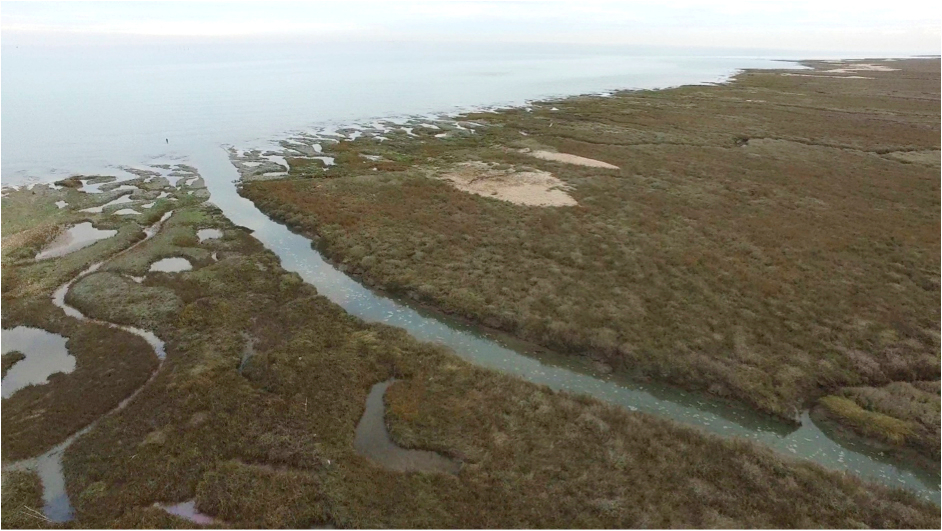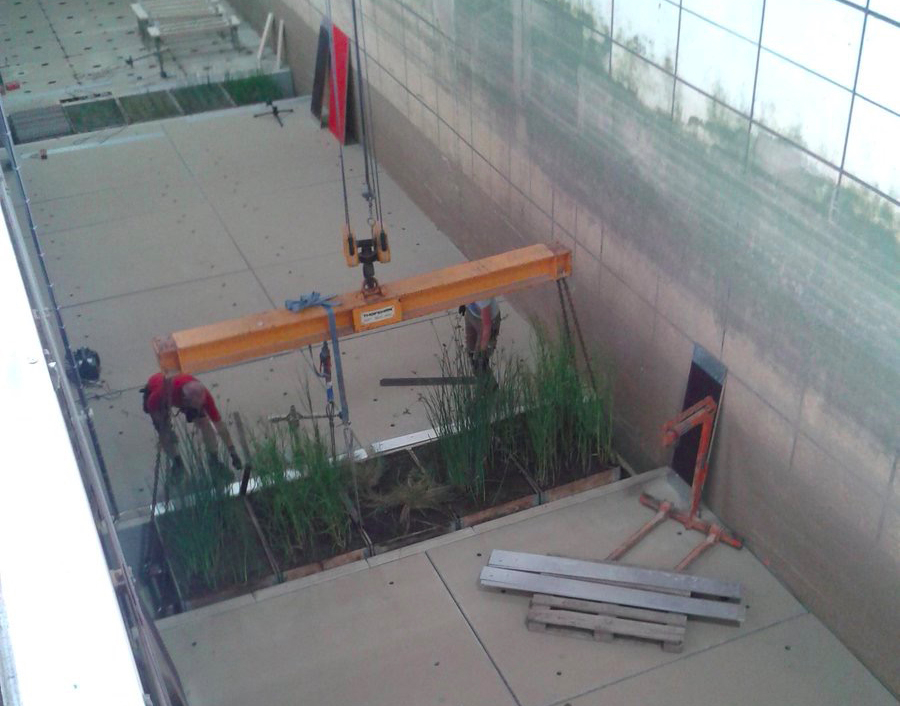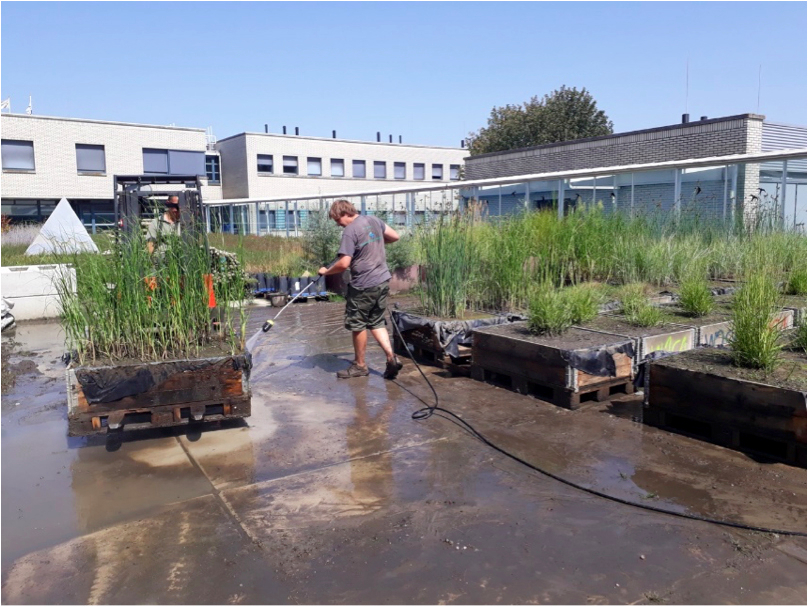Klimaatimpact: kleine planten tegen grote golven

Herstel kwelderplanten
De planten aan de rand van kwelders zijn het meest kwetsbaar. "Zij vangen de grootste klappen op, maar hoe herstellen ze zich? En krijgen hun babyplanten ondanks de stormen genoeg kansen om tot volwassen grootte te groeien en zo het buffersysteem in stand te houden? Dat zijn de vragen waar we ons bij dit experiment mee bezig houden", vertelt Tjeerd Bouma van het Koninklijk Nederlands Instituut voor Onderzoek der Zee (NIOZ) over onderzoeksproject RESIST dat wordt geleid door de Universiteit van Cambridge in samenwerking met de universiteiten van Braunschweig en Hamburg in Duitsland, de Universiteit van Antwerpen in België, en het NIOZ in Nederland.
Stroomgoot experiment in de Grosser Wellenkanal
In de natuurlijke wereld is het nabootsen van golfslag en het meten van stormimpact op de kwelderplanten moeilijk, maar onder gecontroleerde laboratorium omstandigheden kun je allerlei soorten stormen simuleren. Wetenschappers gebruiken daarvoor een kunstmatig kanaal waarin ze grote stormgolven door een proefwad laten stromen, een stroomgoot. Eén van de grootste exemplaren van deze laboratoria staat in Duitsland. De 'Grosser Wellenkanal (GWK)' van de Leibniz Universiteit Hannover en de Technische Universiteit Braunschweig is 300 meter lang, 5 meter breed en 7 meter diep.

Voor het experiment in de goot zijn op het NIOZ in Yerseke kwelderplanten gekweekt in verschillende levensstadia. "We weten gewoon niet hoe belangrijk planten zijn in het aan elkaar binden van de grond en het stabiliseren van het moeras. Ons project zal deze vraag beantwoorden en de allereerste gegevens leveren over hoe deze fascinerende natuurlijke structuren zich verzetten tegen stormen van ieder formaat. De bescherming van deze planten hebben we hard nodig in een tijd waarin de zeespiegel stijgt en stormen steeds krachtiger worden", zegt RESIST projectleider coördinator, Dr. Iris Möller.

Bevolkingsstijging in kustgebieden
Wereldwijd beslaan kwelders aan de kust ruim 756 duizend vierkante kilometer. Bevolkingen aan de kust lopen extra gevaar om getroffen te worden door overstromingen en erosie, vooral in gebieden waar moerassen voor de kust liggen. Naar verwachting zal juist de populatie van kustgemeenschappen in kwelderregio's stijgen van 1,8 miljard naar 2,8 miljard tussen 2000 en 2025 (Dodd en Ong, 2008).
Climate Impact: Small Plants against Large Waves
How strong a storm can our natural coastal protection resist? For so long thought of as worthless ‘swamps’, we now know that salt marshes act as a first line of defence against storm surge waves, reducing storm water levels at the foot of landward sea defences. As a result, vulnerable shorelines and engineered coastal defences are at lower risk of suffering from the impact of climate change, including sea level rise and increases in storm intensities. But we know little of the resistance of these natural buffers to the continued battering they receive from waves and tides and even less about what kind of storm it would take to severely damage these protective fringes altogether. If they do get destroyed, we put people living and working at the coast at risk.

Salt marshes occur on shallow coasts influenced by tides. They provide a habitat for adapted plants and animals, protect the coast, and contribute to climate protection as they store carbon dioxide from the atmosphere. However, if storm surges occur more frequently due to climate change, the system might become imbalanced and lose its protective function for the coast.
Catching and assessing a storm impact in the natural world is a tough thing to do; but we can simulate the impact of storm waves on transplanted saltmarsh soil and vegetation under controlled laboratory conditions. Running big storm waves over a trial saltmarsh needs a big artificial channel, or flume. In one of the largest indoor flumes in the world, the 300m long, 5m wide, and 7m deep Large Wave Flume (Grosser Wellenkanal, GWK), operated by the Leibniz University Hannover and Technical University Braunschweig, the RESIST research project, led by the University of Cambridge in collaboration with the Universities of Braunschweig and Hamburg in Germany, the University of Antwerp in Belgium, and the Royal Netherlands Institute for Sea Research (NIOZ) will now take on the challenge of finding out whether naturally protective salt marshes can resist severe storms.

Rising population coastal wetlands
Coastal wetlands cover 756 thousand km2 globally. While coastal populations are increasingly at risk from flooding and erosion, this is particularly the case on coasts fronted by wetlands (nation states with mangroves may face a coastal population rise from 1.8 billion to 2.8 billion between 2000 and 2025 (Dodd and Ong, 2008)).

Collaborative Partners
This project is funded by the European Commission’s access to large-scale facilities (Hydralab+) funding scheme with additional funds for the UK project team from the Natural Environment Research Council of the UK.
The experiment is carried out at the Large Wave Flume (Grosser Wellenkanal) in Hannover.